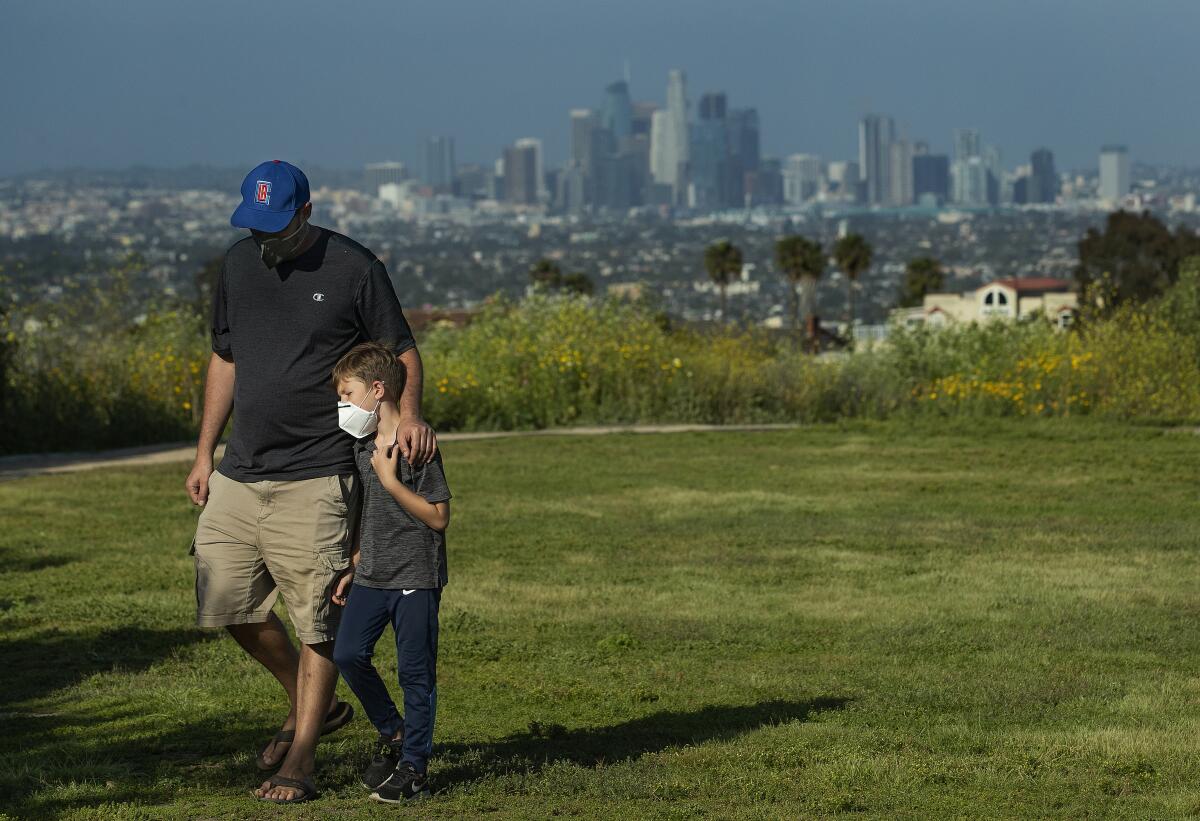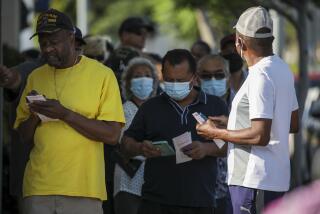California sees first drop in weekly coronavirus deaths. Is it a turning point?

SAN FRANCISCO — California recorded its first week-over-week decline in reported coronavirus deaths, a promising if preliminary sign of progress as Gov. Gavin Newsom prepared to reopen some businesses this week.
Two weeks ago, California reported its highest one-week death toll — 542 fatalities among people infected with the coronavirus between April 20 and April 26. Last week, the weekly death toll fell for the first time, dropping nearly 9% to 495 fatalities for the seven-day period that ended Sunday, according to a Times data analysis.
While it was an improvement, last week’s toll was still the third highest over the course of the pandemic.
These are some of the unusual new scenes across the Southland during the coronavirus outbreak.
Even hard-hit parts of the state saw some relief. Los Angeles County, home to 55% of California’s COVID-19 deaths despite having only one-quarter of the state’s population, saw its reported weekly death toll flatten for the first time: 315 deaths each week for the last two weeks.
The San Francisco Bay Area reported 49 deaths last week, a decrease from the 61 fatalities reported the previous week; San Diego County reported 28 deaths last week, a drop from the 40 reported the previous week. The San Joaquin Valley reported 22 deaths last week, a decline from the 25 reported the previous week, and the Sacramento area reported four deaths last week, down from 12 the previous week. The Central Coast reported three deaths last week, the same as the previous week.
Nationally, nearly 13,000 deaths were reported last week, compared with nearly 14,000 the previous week.
But California still has not seen the sustained 14-day decline in coronavirus cases the White House has suggested as a key criteria before easing stay-at-home orders. The state reported its highest weekly coronavirus case total during April 20-26, with 12,122 cases. Last week, 9,967 cases were reported, an 18% decline, but last week’s case count was still the second-highest weekly total reported during the pandemic.
Statewide, the number of hospitalizations remains steady and flat, with perhaps some initial signs of decreasing, the state health officer, Dr. Sonia Angell, said Monday. The statewide average daily number of hospitalized patients with confirmed or suspected cases of COVID-19 was 4,822 last week, down nearly 2% from 4,905 the previous week.
Hospitalizations have been flat in the five Southern California counties closest to Los Angeles, as well as the San Joaquin Valley and San Diego County. But hospitalizations are noticeably trending downward in the San Francisco Bay Area, the Sacramento region, the Central Coast and the Shasta Cascade region, made up of the eight counties in northeastern California.
California, which has recorded more than 2,200 fatalities, has seen far fewer deaths compared to hot spots such as New York and New Jersey, which have respectively logged deaths of more than 24,000 and more than 7,000. Experts credit early social distancing rules for part of that trend. Newsom announced Monday that some retail stores across the state can reopen for curbside pickup as early as Friday.
The new changes are part of a four-stage plan the governor laid out last week to gradually transition back to normal in a state of nearly 40 million people whose lives have been upended by the COVID-19 health crisis.
But Los Angeles Mayor Eric Garcetti said Monday that different cities will need to take different steps to emerge from the pandemic-induced shutdown and that city and county officials are still trying to determine the safest course.
Only time will tell whether the weekly drop is a momentary blip or marks the beginning of a sustained decline in cases. Experts have warned about a rise in cases and deaths as governments ease stay-at-home orders, and there continues to be worry about a second wave of deadly cases later in the year.
And COVID-19 continues to be a severe threat, having become the leading cause of death in L.A. County, surpassing the previous top killer, coronary heart disease.
“Ninety-five percent of us have still not been infected. And until there’s a vaccine, most residents in L.A. County can be infected at any time over the months to come,” Los Angeles County’s director of public health, Barbara Ferrer, said last week. “Without taking extraordinary measures to reduce our exposures to people who are infected, and to keep our distance as much as possible, we could easily see a big spike in new cases.”
Dr. Scott Gottlieb, former commissioner of the U.S. Food and Drug Administration, said Sunday on CBS’ “Face the Nation” that it’s hard to predict whether the pandemic will become increasingly quiet after June, or if large outbreaks could occur as states ease stay-at-home orders. Currently, the national death toll is more than 68,000, according to Johns Hopkins University, having killed more Americans than the Vietnam War.
“When you look out to the end of June, it’s probably the case that we’re going to get above 100,000 deaths nationally,” Gottlieb said on the CBS program. “But what happens when we come back in the fall and schools are back in session? ... Then you can see this slow simmer explode into a new epidemic or large outbreaks. That’s the concern, that if we don’t snuff this out more, and you have this slow burn of infection, it can ignite at any time.”
Here are charts showing coronavirus-related deaths, hospitalizations and cases by region — Southern California, the San Francisco Bay Area, the San Joaquin Valley, San Diego County, the Sacramento area, the Central Coast and the Shasta Cascade region.
Southern California
Population: 18.6 million
San Francisco Bay Area
Population: 7.7 million
San Joaquin Valley
Population: 4.2 million
San Diego County
Population: 3.3 million
Sacramento area
Population: 2.6 million
Central Coast
Population: 1.5 million
Shasta Cascade region
Population: 585,000
Times staff writer Lin reported from San Francisco and data journalist Lee from Los Angeles.
More to Read
Sign up for Essential California
The most important California stories and recommendations in your inbox every morning.
You may occasionally receive promotional content from the Los Angeles Times.













